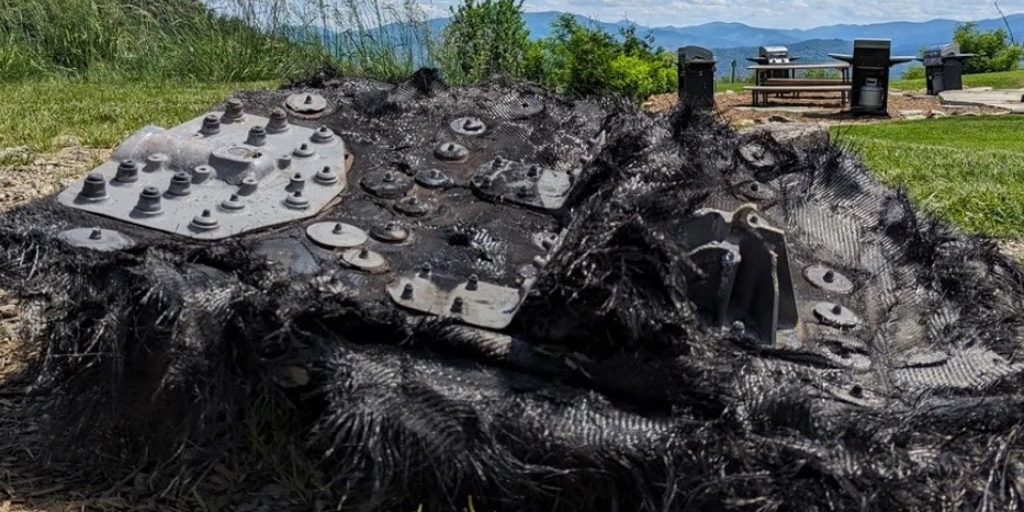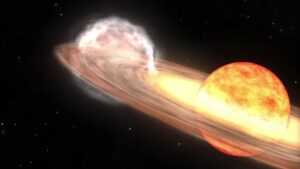Watch a simulation of space debris orbiting Earth
The following graphics are computer generated images of objects in low Earth orbit currently being tracked. Orbital debris points are scaled according to the image size of the plot to optimize their visibility and are not scaled relative to Earth. (Courtesy: NASA ODPO)
WASHINGTON – NASA now acknowledges that debris from SpaceX missions may not burn up completely upon re-entry into Earth’s atmosphere as models previously suggested, increasing the risks of collisions with the surface.
According to the space agency, it is aware of at least five cases where debris destined to break up has reached the Earth’s surface.
Fortunately, none of these events resulted in human injuries or significant property damage. However, a slight change in trajectory would increase the risks to property owners and aviation.
The latest debris discovery occurred on a private mountaintop outside of Asheville, North Carolina, where rangers came across part of a trunk from a Dragon spacecraft.
The trunk, which is designed to carry cargo into space, remains attached to the spacecraft until shortly before re-entry, where the sections separate.
PIECE OF SUSPECTED SPACE DEBRIS FOUND IN RURAL NORTH CAROLINA
“During its original design, the trunk of the Dragon spacecraft was rated for failure on re-entry and was predicted to burn up completely,” a NASA spokesperson said. “Information from debris recovery enables teams to improve modeling of the debris. NASA and SpaceX will continue to explore additional solutions as we learn from the recovered debris.”
It’s unclear what modifications SpaceX might apply to spacecraft to minimize the risk of debris falling through the atmosphere.
The space company has not commented publicly since any of the discoveries, although the pieces of space junk are gaining viral attention.
NASA warns there is the potential for more space debris after SpaceX Crew-8 returns from the International Space Station in August.
If pieces of the crew’s trunk follow a similar timeline to previous debris, the objects will remain in low-Earth orbit until early fall before possibly landing over a community or one of the planet’s vast oceans.
SEE OBJECTS LEFT ON THE MOON
How a piece of space junk ended up in North Carolina
The owner of The Glamping Collective, a private mountain resort in North Carolina, says he plans to display the debris from the SpaceX Crew-7 mission for guests to see.
Who is liable for space junk damage?
Until now, debris from SpaceX missions has landed harmlessly in mostly rural areas of the planet.
However, in the rare cases where damage or injury is caused by falling space debris, a 1972 agreement spelled out who would be liable.
According to the United Nations Office for Outer Space Affairs, “the launching State is absolutely responsible for paying compensation for damage caused by its space object to the surface of the earth or to an aircraft in flight.”
Although the US tracks about 45,400 objects in space, the chance of actually being hit by debris is considered less than one in a trillion.
A Florida man recently beat the odds when a piece of discarded hardware from the International Space Station crashed into his Naples-area home in March.
Fortunately, no one was injured by the approximately two-pound object, but it did cause damage to the residence.
A lawyer representing the family has filed a claim with NASA seeking compensation for the damages.
“Space debris is a real and serious problem due to the increase in space traffic in recent years,” Micah Nguyen Worthy, an attorney at Cranfill Sumner LLP, said in a statement.
A piece of suspected space debris crashes into a house in Naples, Florida on March 8, 2024. (Image: Alejandro Otero / LOCAL NEWS X /TMX) (Alejandro Otero / LOCAL NEWS X /TMX)
NASA advises anyone who comes across space debris to never touch the object and to contact local authorities.
SpaceX has set up a hotline at 1-866-623-0234 for witnesses to contact if debris from its missions is found.



